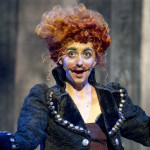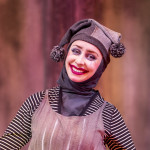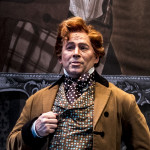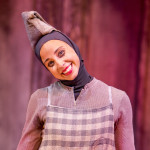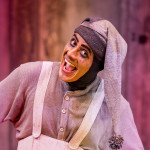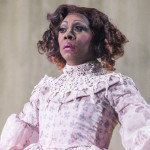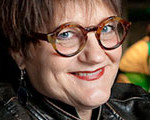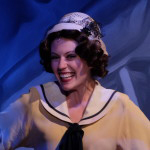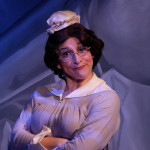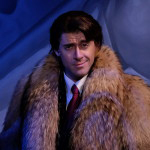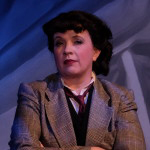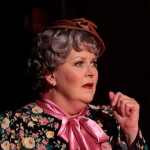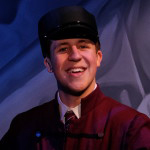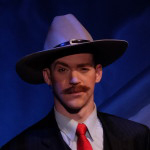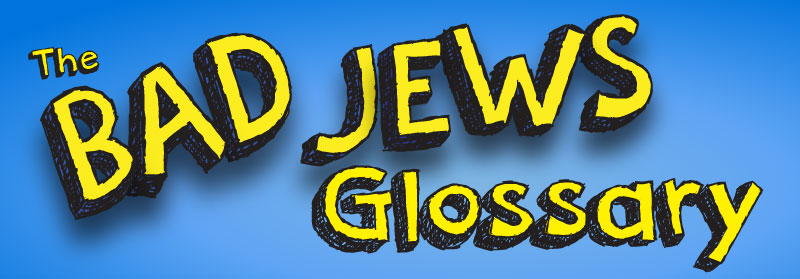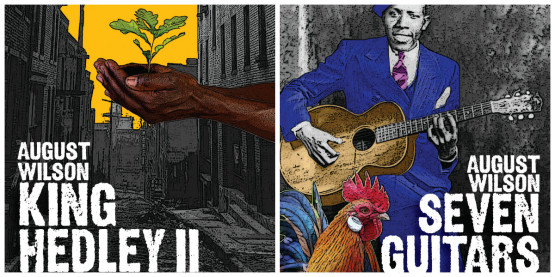Q&A: Shockheaded Peter
There is nothing really that compares to Shockheaded Peter. Our creative and design teams were tasked with building an entire production based on less than 30 pages of dialogue. Difficult? Yes. Challenging? For sure. Yet, everyone involved in this extraordinarily original and creative production has remarked that it has been one of the most rewarding experiences of their theatrical careers.
We asked them a few questions about the making of this wild and crazy ride.
What attracted you to the show? Choreographer Michael Mizerany!
It’s been described as vile, despicable, horrific, and absolute bliss. What words would you use to describe it? Scary, fantastic, thrilling, dark, smart.
What do you find most challenging and exciting about working on this production? Is there anything you can tell us about the creative process? Creating an entire show from 23 pages of text was such a wonderful experience. The rehearsal room was so open and encouraging. Learning how to clown was quite the experience!
What attracted you to the show? Rob Lutfy. I had never heard of the show and he spoke about it to me about a year ago. I listened to some of the soundtrack by the Tiger Lillies and it’s about the weirdest thing I’ve ever listened to. So of course I was fascinated! Being a weirdo myself, I looked forward to not only working on the show but working with and under Rob’s direction. It’s the kind of show that can be anything you want it to be. There is no structure. The script is a barely 30 pages and no written music for the band. So what you see here, you’ll never see again. This is all from the minds that have come together for this project here at Cygnet. It’s been an experience I’ve never had before. Pure collaboration and overwhelming generosity. I have learned so much from this entire process and couldn’t be more thankful.
It’s been described as vile, despicable, horrific, and absolute bliss. What words would you use to describe it? I think it is morbidly beautiful. It’s grotesquely awe inspiring. Human. There is a strange juxtaposition of beauty that comes from the horrible things that can happen in life.
What do you find most challenging and exciting about working on this production? Is there anything you can tell us about the creative process? It’s been such a generous group of people that I have felt nothing but support along the way. I am not the spectacular element of the show, but I am compelling it to happen. It’s also a character that is not something I typically play and yet there is still something within that I am finding I can identify with.
What attracted you to the show? The bizarre theatrical aspect.
It’s been described as vile, despicable, horrific, and absolute bliss. What words would you use to describe it? Frightening, playful, sadistic, unsettling, intriguing.
What do you find most challenging and exciting about working on this production? Is there anything you can tell us about the creative process? It can be difficult to remember all of the content we go through in a single rehearsal, but it’s a very welcomed challenge. Devising theatre is not easy, but it’s one of the most rewarding processes for an actor. To truly create your own track and show with a group of other professionals; absolute bliss. Plus it’s really scary, dark stuff that makes it all the more interesting to dive into.
What attracted you to the show? The creative team, the fact that it hasn’t been done in this area before, and the abstract story.
It’s been described as vile, despicable, horrific, and absolute bliss. What words would you use to describe it? Abstract, physical, heart-wrenching, dark, fun.
What do you find most challenging and exciting about working on this production? Is there anything you can tell us about the creative process? It’s pushing the limits and taking me out of my comfort zone, which is exciting and challenging. I am learning a lot and doing things I’ve never done or seen before on stage.
What attracted you to the show? Rob Lutfy. I love the way he works.
It’s been described as vile, despicable, horrific, and absolute bliss. What words would you use to describe it? I understand the adjectives previously used to describe the show, but I believe this production offers a new narrative and context for the horror. One might even see redemption and closure for the show’s main characters.
What do you find most challenging and exciting about working on this production? Is there anything you can tell us about the creative process? This is the kind of opportunity actors fear and relish simultaneously! It’s a chance to collaboratively create theatre. A high risk, high reward situation.
What attracted you to the show? I have never worked for Cygnet before, but always heard amazing things about it. I am fairly new to the musical theatre scene and have only done classical shows. This is the first time doing a show so far outside my comfort zone, and I can already tell how much I have learned and gained from doing it. It is an amazing opportunity to push our boundaries and be transported to a new world.
It’s been described as vile, despicable, horrific, and absolute bliss. What words would you use to describe it? Artistic, passionate, creepy, distorted, other worldly.
What do you find most challenging and exciting about working on this production? Is there anything you can tell us about the creative process? The most challenging aspect has been breaking my natural habits as a technical dancer to become the creature or character appropriate for the show. It has been about taking what is so ingrained in my body and manipulating it to something new, creative, and distorted. The creative process has been incredibly unique because we are creating something new and organic. From day one, Rob created a comfortable environment that made us feel safe to explore and play. This has been the most collaborative show I have ever done. It is our show, not just a show.
What attracted you to the show? I love all things horror/creature related and out of the norm.
It’s been described as vile, despicable, horrific, and absolute bliss. What words would you use to describe it? Creative, out of the norm, reality meets nightmares, and the “What if all the things your parents tried to scare you with really did happen?!” It’s a one of a kind masterpiece of how children who misbehave get punished. It brings you back to those myths you’d believe as a child.
What do you find most challenging and exciting about working on this production? Is there anything you can tell us about the creative process? Being part of the ensemble cast means I’ll be playing different characters, which, I love. But sometimes changes can occur in a flash, and I have to snap out of one character into the next in a matter of seconds.
What attracted you to the show? I was most attracted to the music, dark, and bizarre story. It also appealed to me because the script is so short, that I was intrigued as to how the cast along with the director and the production team were going to turn this into a full-fledged musical.
It’s been described as vile, despicable, horrific, and absolute bliss. What words would you use to describe it? Intriguing, bizarre, demonic, volatile, strange, scary, shocking, cruel, dark, grotesque, macabre, genius, fun, amusing.
What do you find most challenging and exciting about working on this production? Is there anything you can tell us about the creative process? The most challenging, yet exciting part about working on this production is the idea that the script is simply a road map for the show and that we are having to build a show from the ground up. I am not sure that I was initially prepared for the dark places that this show would take me, but by having the ability go to those dark places and transform, those are the times where I am able to find the humor in the show because the show is so extreme. I think that this show would push any performer out of their comfort zone because it is forcing each of us to step out of what we know as traditional theatre. It is hard to know in a show like this what is going to be too much, but we work together really well collectively, as an ensemble to ensure that we are telling the story the way that each of us wants to.
What attracted you to the show? Working with director Rob Lutfy.
It’s been described as vile, despicable, horrific, and absolute bliss. What words would you use to describe it? Your wildest nightmares made reality.
What do you find most challenging and exciting about working on this production? Is there anything you can tell us about the creative process? The most exciting thing is the collaborative, improvisational creative process. Rob excels at hiring exceptional people both cast and production team and then giving them the freedom to create. Through it all, Rob is always there to lend his expert opinion and guide the ship with his vision.
What attracted you to the show? The subversive nature of the text and songs but also working with Rob Lutfy again.
What do you find most challenging and exciting about working on this production? Working with a such wonderful creative team is the most exciting part.
What attracted you to the show? As a visual artist, designing Cygnet’s production of Shockheaded Peter is a quintessential project because seldom does the costume design play such a defining role for the entire production. Yes, costume always supports the individual character and production, however for me, since Shockheaded Peter is actually a picture book come to life, the picture becomes the focus and the words, or text, play the supporting role. You may be able to establish fear and influence the behavior of someone with words, but visually showing reasons for fearing is clearly more powerful.
It’s been described as vile, despicable, horrific, and absolute bliss. What words would you use to describe it? A visual thriller with a chilling aftertaste!
What do you find most challenging and exciting about working on this production? Even though the text for Shockheaded Peter is a mere 22 pages, the visual presentation requirements found within present large design challenges. The creative team has approached these challenges through the use of physical and visual theatre. There are so many images that have helped shape and frame the design language being used. Strongest influences for me have been: the picture book itself, German Expressionism, The Cabinet of Dr. Caligari, Tim Burton, Grand Guignol, and Comedia Del Arte. Collectively, the creative team is striving to bring the audience member into that dark imagination, incite a bizarre discomfort and alarm that would manifest as nervous laughter. And when they are asked in the show, “What is under your floorboards?” hopefully an almost audible shiver will be felt throughout the theatre.
Catch Shockheaded Peter through June 18th!
4 Key Influences of Shockheaded Peter
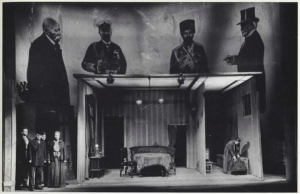
EPIC THEATRE was a theatrical movement that arose in the early to mid-20th century from the theories and method of a number of theatre practitioners (namely Bertolt Brecht) who responded to the political climate of the time through the creation of new political theatre. Epic theatre is often characterized by a series of loosely connected scenes that avoid illusion and often interrupt the storyline to address the audience directly with analysis, argument, or documentation. Brecht wanted his audiences to adopt a critical perspective in order to recognize social injustice and exploitation and be so moved as to effect change in the world outside the theatre walls. By highlighting the constructed nature of a theatrical event and employing various techniques used to remind the spectator that a play is a representation of reality, and not reality itself, Brecht hoped to communicate that the audience’s reality was equally constructed and, as such, was changeable.
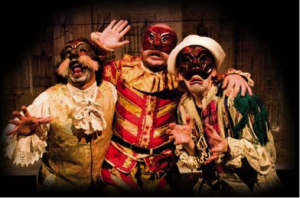 COMMEDIA DELL’ARTE is a theatrical form that emerged in northern Italy in the fifteenth century and rapidly gained popularity throughout Europe. It is characterized by improvised dialogue and a cast of colorful, masked stock characters. Performances were based on a set schema, or scenario—a basic plot, often a familiar story, upon which the actors improvised their dialogue, leaving actors to tailor a performance to their audience, allowing for sly commentary on current politics and bawdy humor that would otherwise be censored. The characters of the commedia usually represent fixed social archetypes, or stock characters, such as enamored lovers, foolish old men, devious servants, or military officers full of false bravado. And each stock character of the commedia evolved a distinct set of attributes—characteristic speech, gestures, props, and costume—that became standard to the portrayal of the character. All characters except for the lovers and the comic servant wore masks, a tradition deriving from ancient Roman comedies that featured similar character types. Because the mask partially or entirely obscured facial expression, emphasis was placed on dialect (often reflecting regional stereotypes) and exaggerated gesture to convey emotion and intention.
COMMEDIA DELL’ARTE is a theatrical form that emerged in northern Italy in the fifteenth century and rapidly gained popularity throughout Europe. It is characterized by improvised dialogue and a cast of colorful, masked stock characters. Performances were based on a set schema, or scenario—a basic plot, often a familiar story, upon which the actors improvised their dialogue, leaving actors to tailor a performance to their audience, allowing for sly commentary on current politics and bawdy humor that would otherwise be censored. The characters of the commedia usually represent fixed social archetypes, or stock characters, such as enamored lovers, foolish old men, devious servants, or military officers full of false bravado. And each stock character of the commedia evolved a distinct set of attributes—characteristic speech, gestures, props, and costume—that became standard to the portrayal of the character. All characters except for the lovers and the comic servant wore masks, a tradition deriving from ancient Roman comedies that featured similar character types. Because the mask partially or entirely obscured facial expression, emphasis was placed on dialect (often reflecting regional stereotypes) and exaggerated gesture to convey emotion and intention.
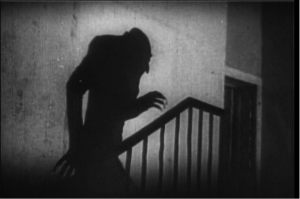

GERMAN EXPRESSIONISM refers to a series of related creative movements beginning in Germany before World War I that reached a peak in Berlin during the 1920s. As part of the larger Expressionist movement in North and Central Europe in fields such as architecture, dance, painting, sculpture and cinema, it emphasized directness, frankness, and a desire to startle the viewer. German cinema in particular had a major influence on American films, particularly in the genres of horror and film noir. The Cabinet of Dr. Caligari, a 1920 German silent horror film directed by Robert Wiene and written by Hans Janowitz and Carl Mayer, is considered by many to be the quintessential work of German Expressionist cinema.
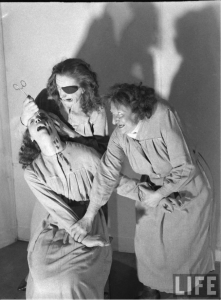
THE GRAND GUIGNOL (1897-1962) was a theatre in the Pigalle area of Paris that specialized in naturalistic horror shows. Its name is often used as a general term for graphic amoral horror entertainment, a genre popular from Elizabethan and Jacobean theatre through today’s splatter films. Their popular and well-known horror plays featured a distinctly bleak worldview, as well as notably gory special effects in their notoriously bloody climaxes.
Fall into the world of Victorian steam-punk nightmares as a manic music box spins stories of naughty children and misguided parents. Silly and sinister, Shockheaded Peter dares us to ask what’s beneath the floorboards.
Don’t miss the most damning tale ever told on stage! Runs through June 18th.
Actor Q&A: The 20th Century Cast
For many in our cast, musical theatre is in their blood and they jumped at the chance to perform in this rarely produced comic gem. For musical theatre fans, On the Twentieth Century has almost a cult following. In the 1978 Broadway season, the show garnered nine Tony nominations, winning five but it is barely produced because of the challenge of depicting the luxury train on stage. We can’t wait to show you how we did it!
Meanwhile, we asked our cast a few questions about the show, their favorite musicals (hint: Think Sondheim) and of course, trains.
Have you ever seen a production or better yet, appeared in On the 20th Century? In 2011, I was a porter in a production at Theater at Monmouth in Maine.
Why do you love Musical Theatre? I love how music & language work together.
What is your Favorite Musical? Into the Woods
Do you have a favorite train memory? I fondly recall backpacking through Europe on trains in college.
Why do you love Musical Theatre? It’s the best! Storytelling through music!
Why do you love Musical Theatre? It has it all. Music, passion, heightened emotion & silliness.
Have you even seen a production of On the 20th? I saw LA Encores production with Carolee Carmello.
Favorite Train Story? The Little Engine That Could & Polar Express
Favorite Train Story? Murder on the Orient Express
Favorite Musical? I am not sure I have a favorite musical, but I do have a favorite composer. Stephen Sondheim speaks to me like no other composer can. He writes strong yet vulnerable women and his music is challenging and honest.
Have you ever seen a production or better yet, appeared in On the 20th Century? I was in the staged reading at Cygnet theatre 7 years ago. I was in the ensemble the first night but the 2nd night, the actor playing Owen (Phil Johnson) got sick and couldn’t perform. After searching all of San Diego frantically for a male to play take over, he called me at 11am that morning and asked if I could do it. Always up for a challenge (never being able to say no to Sean), I went on that evening with about 2 hours rehearsal. Of course that was the night Cy Coleman’s widow was in the audience. It was crazy insane and fun!
Why do you love musicals? I love Musical Theatre because it’s hard to do and I like to sing and act…two birds one stone!
Favorite Musical? Too many favorites to pick.
Favorite Train Story? Polar Express
Why do you love Musical Theatre? Do you have a favorite? I love theatre, plays, not specifically musicals. I think my all-time favorite musical is Sweeney Todd, which I got to do at Cygnet! I also write musicals and have had many produced, such as Everybody’s Talkin’ and Suds (co-written with castmate Melinda Gilb) which started in San Diego and moved to New York and has had dozens of productions worldwide.
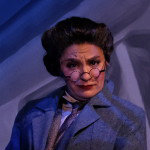 Samantha Wynn Greenstone
Samantha Wynn Greenstone
Why do you love Musical Theatre? Sometimes the only option is to break out in song.
Do you have an all-time favorite musical? The Drowsy Chaperone
Why do you love Musical Theatre? It allows the actor to dive into a character and give the audience a truthful, honest performance which allows the audience to enjoy themselves and forget about life for 2 hours, as well as potentially learn something new about themselves or the world from the lessons and themes conveyed in the show.
Why do you love Musical Theatre? Do you have a favorite? I love singing, and I love performing in a heightened reality. I’ve been doing Musical Theater since I was eight, it’s pretty much a part of me at this point. All-time favorite…Bonnie and Clyde the Musical, or Urinetown, or Rent, or Spring Awakening.
Catch all these talented actors through April 30th!
HOW TO PUT A TRAIN ON STAGE
Our production of the screwball comedy On the 20th Century literally takes aboard the Twentieth Century, a luxury train traveling from Chicago to New York City. The original production is partly famous for its breathtaking silver art deco train. We challenged our cracker- jack design team to find a way to bring that magnificent train, and the era it evoke, to life on the Cygnet stage. Sean Murray, Sean Fanning and Blake McCarty tell us how they brought their “mad genius” to the project. Hint to our loyal readers: think projections!
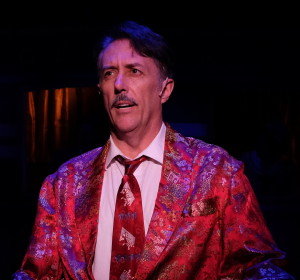
Sean Murray, Director
The biggest challenge of this show is that one of the main characters is a very famous luxury train of some opulence. My suspicion about why this great musical hasn’t been produced as often as it deserves is the challenge that poses to most companies. It has baffled me for years. It is intimidating to try to recreate that today, let alone on our stage.
I found the hook into how to do it while reading an adaptation of the original play. (Yes, it was a play first.) It opened in the early 30s and was an enormous hit. The play was adapted into a film with John Barrymore and Carol Lombard in the early 30s. It was considered to be one of the first “screwball comedies” of that era. The play was revived in the 1950s with Jose Ferrer and Gloria Swanson. In the 90s, Ken Ludwig did an adaptation of the play, reducing the number of actors and characters to make it more producible. This played at the Roundabout with Alec Baldwin and Anne Heche.
As I was reading this play, it suddenly occurred to me that none of these stage versions had presented the train as anything near what the original Robin Wagner (Tony Award for Best Set Design, 1978) set was. It was a basic one set show and the three compartments of the Pullman car were always present. If we can do the train car as it was originally done in the play, the new challenge would be how to establish the presence of the mighty train itself. We hit upon the idea of utilizing projections above the train car. These would be atmospheric, cinematic in its portrayal of the train as seen from out outside, spinning wheels, steam, tearing down the track, clouds whistling by etc. Suddenly this idea of projections would help us give a visual of the train itself, and also create a way to take us off the train into the flashbacks and fantasy sequences that are unique to the musical.

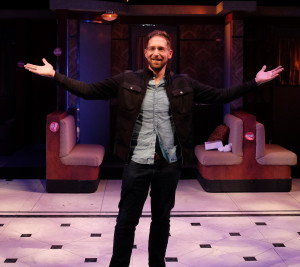
Sean Fanning, Set Designer
The world of On the Twentieth Century is inspired directly by the Streamline Moderne movement, which came about in the 1930’s. It was a form of art and architecture that took the elaborate detail of Art Deco and simplified it, adding aerodynamic curves and metallic accents, emphasizing speed, movement and modernity. The famous exterior of the train, designed by Henry Dreyfuss, is a recurring icon of the production. It’s the central, stylized image represented in the show curtain, as well.
To incorporate projections into this production, it was necessary to create a framework or proscenium around the train that could both evoke train terminals when we wanted it to, but also take us to other places – particularly in the “flashback” or memory moments. We’ve been working to come up with a projection vocabulary that can both give us a sense of place and composition with the set, but also the illusion of travel, and visual fantasy to work with the music of the piece. Integrating projections into the set architecture is a reaction against putting a literal, rectangular “projection screen” above the set, which would counteract everything about the Streamline Moderne look and the theatrical feel we’re going for. Made up of deco columns, our portal accommodates the widest singular set piece Cygnet has ever done.
The design takes a little flight of fancy and emphasizes the class level of the passengers on this cross section of the train. It tries to imagine what lives in our imaginations when we think of glamour and travel in the 1930’s. Stained wood paneling, stylized wallpaper, chrome trim and hardware, and customized upholstery. The color palette of the drawing rooms is in what I would call “champagne tones,” with a very tight tonal range that gives it a more vintage feel.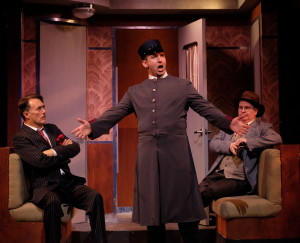
Ultimately, the phrase I’ve been repeating to myself throughout this whole process is “form follows function.” Everything about this set is intended to allow the screwball comedy to germinate within the finite confines of the train. The layout of doors, for example, is integral to the action of the play (more so than usual). The design of the floor works to demarcate the imagined downstage edge of the train car, and gives us playing area beyond this where the flashback or musical moments can then “overflow” from the parameters of the train.
Blake C. B. McCarty, Projection Designer
 “Form following function” speaks to my largest challenge. Projections are not generally integral to plot and the actors almost never interact with them directly. Instead, they serve three primary functions: to heighten the sense of spectacle and awe for the train itself; to provide a consistent sense of place and motion; and to expand the zany, madcap sensibility of the show.
“Form following function” speaks to my largest challenge. Projections are not generally integral to plot and the actors almost never interact with them directly. Instead, they serve three primary functions: to heighten the sense of spectacle and awe for the train itself; to provide a consistent sense of place and motion; and to expand the zany, madcap sensibility of the show.
Unlike with Rocky Horror Picture Show last year, this show will have projections at virtually every moment of the performance. And as advanced as the technology may be that we’re using, it’s also important to me that we don’t lose the sensibility of this era. As a result, we’re using a few different modalities or styles that are rooted in the period. First and foremost is film itself, with black and white images and footage that resembles the newsreels that would have played before feature films. Wherever possible, I’m actually culling cinematic material from period sources. Educational and industrial film archives are an incredible resource.
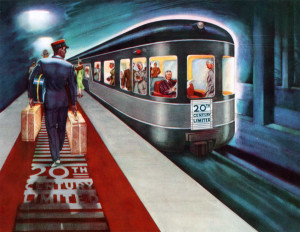 In moments of heightened reality, the visual language will shift to something far brighter and colorful inspired by graphic design from the 1930s. I have always loved travel posters from that era, and looked to artists like Adolphe Mouron Cassandre for inspiration. The WPA also employed a tremendous number of artists, and developed a style that remains iconic to this day. Picture a poster for any of the National Parks and you’ll most likely conjure a bold image with strong typography and a colorful palette constrained to a limited number of colors because most of the posters were silkscreened.
In moments of heightened reality, the visual language will shift to something far brighter and colorful inspired by graphic design from the 1930s. I have always loved travel posters from that era, and looked to artists like Adolphe Mouron Cassandre for inspiration. The WPA also employed a tremendous number of artists, and developed a style that remains iconic to this day. Picture a poster for any of the National Parks and you’ll most likely conjure a bold image with strong typography and a colorful palette constrained to a limited number of colors because most of the posters were silkscreened.
Lastly, we periodically slip into something more purely absurd that doesn’t attempt to maintain period, but rather embraces the sheer silliness of the show.
National Comedy Theatre at Cygnet
We’re looking forward to National Comedy Theatre’s full-length improvised musical, aChording to us, one night only at Cygnet Theatre April 24th! We sat down with NCT Artistic Director, Gary Kramer, to learn more about the show.
Cygnet: Tell me a little bit about National Comedy Theatre and specifically aChording to Us, your full length improvised musical.
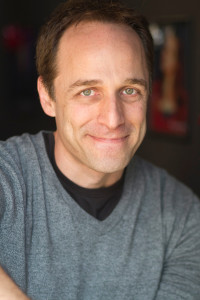
Gary: This is our 18th season at the National Comedy Theatre, which is located right down the street from Cygnet on India Street – next to Shakespeare’s pub. We have a very talented cast of professional comic actors who perform improvised scenes every night based on suggestions from the audience. We perform around 300 shows every year, and on March 18th will have performed our 5000th consecutive show.
Cygnet: How is aChording to Us different from your weekly mainstage performances?
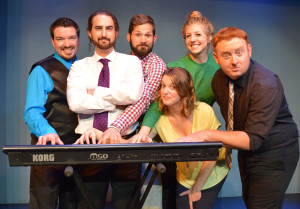
Gary: We have a number of different themed performances that have established their own audience over the years. One of the most popular is aChording to Us, in which our cast improvises a new full length musical theatre piece each night. The audience makes a story line suggestion, the keyboardist starts playing…and a musical is created on the spot. It’s pretty incredible. aChording to Us features some of San Diego’s finest comic musical talents. Chris Daily, Allison Ramsay, Michael Maury, Rachel Pomeroy & Casey Gardner. The talented Yaron Guez is on keys – deciding when the story turns to song….
Cygnet: Why do you think Cygnet Theatre patrons will enjoy this show?
Gary: I am a regular Cygnet Theatre patron myself – and enjoy the creative filter here. Cygnet has the ability to take a familiar story and look at it differently – thinking outside the box. That ability to think outside the box and show stories in a different way is a big part of how National Comedy Theatre operates as well. We create as we go…and adding the musical element into that adds a level of creative energy that I know will resonate with the Cygnet audience. Plus, the show is just flat out funny and unexpected. The cast and audience both go on the same journey during the performance, and the discovery of where the story leads is a major component of the fun quality to the show. We honestly do not know where there show will lead, and that creates the edge to the performance for both cast and audience.
aChording to Us
a full-length improvised musical…
by National Comedy Theatre
Monday, April 24th at 7pm
Cygnet Theatre, Old Town
The audience gives ONE suggestion.
And a brand new full-length musical is born…
While. You. Watch.
National Comedy Theatre, San Diego’s long running, professional improv comedy theatre, brings their musical theatre performance – aChording to Us – to Cygnet Theatre. The audience gets the ball rolling… the keyboard starts playing…and a new musical is created as you watch. Improvisation at its most adrenaline-surging finest.
Musical theatre lovers, improv fans and those of us who are just WAITING for someone to screw up…this one is for you! aChording to Us, a NCT production, features some of San Diego’s finest comic talents. Chris Daily, Allison Ramsay, Michael Maury, Rachel Pomeroy & Casey Gardner. The incredible Yaron Guez is on keys – deciding when the story turns to song….
Click here to Purchase Tickets or call the Cygnet Box Office at 619-337-1525
Good Jew or Bad Jew?
Good Jew or Bad Jew? It’s a pretty good question and one that is not easy to answer. We asked our talented cast anyway and here is what they had to say. We asked a few other questions while we were at it!
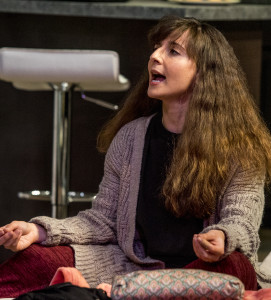
Danielle Frimer
Are you a Good Jew or a Bad Jew? A medium Jew? Most of the Hebrew has left the ol’ noodle, and I only sporadically observe the holidays, but I like to think that some of the moral/ethical underpinnings of Judaism have made their way into my value system.
Who are your Jewish influences in the arts or theatre? To name a few…Deb Margolin, Tony Kushner, Tom Stoppard, Jill Soloway.
How does this family dynamic relate to your own life? I relate to arguing as a way of expressing deep love, and to the familial grappling with questions of religious and cultural identity.
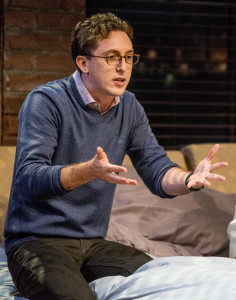
Josh Odsess-Rubin
Are you a Good Jew or Bad Jew? Definitely in a traditional sense am a “bad Jew” in that I almost never go to temple, I don’t fast when you should fast, or keep kosher or anything. But I like to think I’m an “okay Jew” in that I try to live my life by some key ideas like the golden rule, and Tikkun Olam, the Jewish concept of healing the world.
How does this family dynamic relate to your own life? I should remain vague to not get into trouble, but echoes of Bad Jews’ plot strongly reverberate on both sides of my family! Luckily, however, I get along very well with all my cousins, and personally have never had a crazy battle of wills like that between Daphna and Liam.
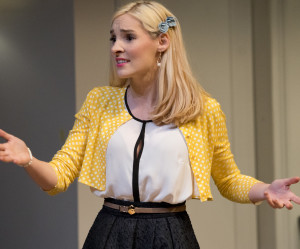
Katie Sapper
Are you a Good Jew or a Bad Jew? I’m not Jewish but consider myself a “Good Jew” ally.
Who are your Jewish influences in the arts or theatre? I really admire the works of Tony Kushner. The dimension he brings to his characters are so grounded. I think he keeps such a fresh perspective and challenges his audiences. I’m also a big fan of Eve Ensler – her play Necessary Targets has a special place in my heart and I love her call to social justice.
How does this family dynamic relate to your own life? Any family that deals with losing a loved one encounters those uncomfortable conversations about keepsakes and what tangible reminders are left behind can relate to this story, as well as anyone who’s ever been introduced to a significant other’s family and tries to make a good impression. That underlying tension and desire to be liked is very real.
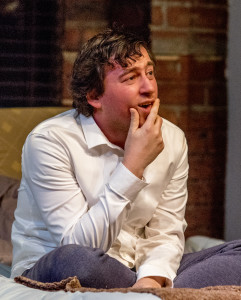
Tom Zohar
Are you a Good Jew or Bad Jew? I don’t believe the distinction really exists. Technically some might say I’m a “Bad Jew” because I don’t keep kosher or observe the high holidays, I am not religious and I migrated away from the holy land when I was very young. But I am also a proponent of Jewish culture, I speak proudly on being a Jew and I am proud of my heritage. So who knows?
Who are your Jewish influences in the arts or theatre? Tony Kushner is a big influence, and his work always deals with themes of Jewish culture and heritage. Harvey Fierstein and “Torch Song Trilogy” made an impact on me as a gay Jew. And of course Fiddler on the Roof is a classic.
How does this family dynamic relate to your own life? There is a history of heated, loud and passionate people within my family and I can definitely see them reflected here. Jonah’s attempt to keep the peace while the others fight is something I can relate to within my own role in my family, especially following my parent’s divorce.
Good Jews runs now through Feb. 12, 2017. Buy tickets HERE.
Season 15 Announced!
Seven Shows Ranging from Classic Comedy to World Premiere
Do you remember when you were fifteen years old? Everything was exciting, emotional and life or death. That’s exactly like our 15th season, without all those annoying “changes”. Here at Cygnet, in the last fifteen years, we’ve learned to push boundaries, explore the new, and stay relentlessly passionate. Join us, because when you’re fifteen the best is yet to come!
 Season XV: 2017 – 2018
Season XV: 2017 – 2018
List of Plays
Animal Crackers
July 5 – Aug. 13
Book by George S. Kaufman and Morrie Ryskind
Music and Lyrics by Bert Kalmar and Harry Ruby
Directed by Sean Murray
Music Direction by Terry O’Donnell
Hooray for Captain Spaulding! When a celebrated painting goes missing from Mrs. Rittenhouse’s fancy house party in honor of African explorer Captain Spaulding, her guests set out to find the thief in a series of madcap antics and exploits. Based on the original Marx Brothers Broadway hit and film classic, this adaptation of Animal Crackers is an outrageous, rollicking, laugh-out-loud musical comedy, complete with audience participation! Featuring a cast including Josh Odsess-Rubin and Bryan and Katie Banville.
“Delicious…A nonstop riot – a profusion of puns, gags, and hysteria with only an occasional pause (or maybe, gasp) for breath.” – The Washington Tribune
The Effect of Gamma Rays on Man-in-the-Moon Marigolds
Aug. 30 – Sept. 24
By Paul Zindel
Directed by Rob Lutfy
This Pulitzer Prize-winning lyrical drama tells the story of a wounded family unraveling at the age of innocence and at the age of no return. Life in the 1960s with Beatrice, an embittered single mother, resembles a hell more than a home for her two daughters. But Tillie, the youngest, finds her own way to connect to the world with resilience and hope. Tillie — keeper of rabbits, dreamer of atoms, true believer in life, hope, and the effect of gamma rays on man-in-the-moon marigolds.
“The play itself is one of the lucky blooms; it survives, and is beautiful.” —NY Times.
The Legend of Georgia McBride
Oct. 11 – Nov. 12
By Matthew Lopez
Directed by Sean Murray
San Diego Premiere
He’s young, he’s broke, he’s just found out his wife is going to have a baby, and now Casey has lost his gig as an Elvis impersonator. When his club brings in a drag act led by Miss Tracy Mills, Casey is given the opportunity to trade one sequined outfit for another. This music-filled comedy celebrates finding your voice and singing your own song. Featuring San Diego favorite David McBean.
“A stitch-in-your-side funny first-rate production full of sass and good spirits.” –The New York Times
“A highly-entertaining, genuine crowd pleaser.” — Hollywood Reporter
A Christmas Carol
Nov. 29 – Dec. 24
Adaptation & Lyrics by Sean Murray
Original Score by Billy Thompson
Directed by Sean Murray
Musical Direction by Patrick Marion
Cygnet Theatre invites you to start your own family tradition with one of ours. This season welcomes the return of the holiday classic adapted from Charles Dickens’ timeless tale of hope and redemption. Featuring original music, creative stagecraft and puppetry, and live sound effects. Step into a Victorian Christmas card for a unique storytelling experience that is sure to delight the entire family!
“Critics Pick” in 2014 & 2015 – San Diego Union Tribune
The Last Wife
Jan. 17 – Feb. 11
By Kate Hennig
Directed by Rob Lutfy
West Coast Premiere
This contemporary re-imagining of the compelling relationship between Henry VIII and his last wife, Katherine Parr, is a witty and powerful examination of sexual politics and women’s rights. It’s a high stakes game of chess, with Henry’s offspring, Mary, Elizabeth, and Edward as pawns.
“The show is stimulating… Surviving a tyrant was far from her only achievement. – The Chicago Tribune
A Little Night Music
Mar. 7 – Apr. 22
Music and Lyrics by Stephen Sondheim
Book by Hugh Wheeler
Directed by Sean Murray
Cygnet is thrilled to revisit one of its favorite musicals. Desirée Armfeldt has always captured the hearts of men. When both of her lovers—and their wives—show up for a weekend in the country, a tangled web of love and desire lead to humorous and heartbreaking revelations. Sophisticated, literate and stylish, but also disarmingly warm, funny, charming and very human. Featuring the hit song, Send in the Clowns and starring Karole Foreman, Sandy Campbell, David Humhrey, and Sean Murray.
“sumptuous and triumphant production” –SD Union-Tribune (2008 review, original mounting)
Critics Circle Winner – Outstanding direction of a musical, Sean Murray
The Wind and the Breeze
World Premiere
May 16 – Jun. 10
By Nathan Alan Davis
Directed by Rob Lutfy
Sam, the legendary, undisputed, greatest emcee in Rockford, IL, plans to rest on his laurels all winter and, if possible, stake out an early spot to watch the Independence Day fireworks -but his closest mentees and their outsized dreams challenge him to a battle he can’t win. The Wind and the Breeze explores the politics of place, the unspoken expectations of friendship and what happens when we choose to stand our ground on shifting sands.
“Because ultimately what makes it soar is Davis’ uniquely lyrical script, and its thematic veracity and original authorial voice floats us past fleeting new-play issues.” -LA Times
“I wish that other playwrights…could be as skillful as Nathan Alan Davis.” -DC Theatre Scene
Tickets and new subscriptions will be available for purchase on March 1st.
Director Insight: Rob Lutfy
Director Rob Lutfy on Bad Jews…
Running Jan. 12 – Feb. 12, our Bad Jews director Rob Lutfy shared a a few of his thoughts on this savage comedy about faith and family.
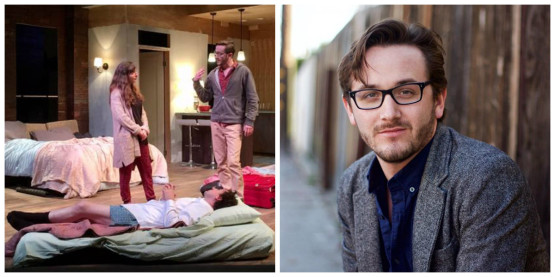
First things first, I am not Jewish–lets get that out of the way. When I first saw a production of this play I was surrounded by Jewish people, we talked after the show in the theatre, and then into the lobby until we were kicked out, and then into the parking lot where someone finally said, “hey want to go into this bar for a drink.” Good theatre starts a conversation. Great theatre ignites debate, albeit hopefully friendly. Igniting debate is a pillar of Cygnet’s mission.
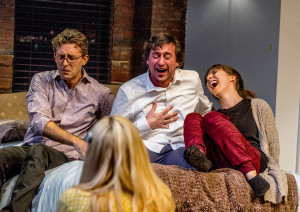
All people are born with some cultural, ethnic, or religious inheritance. What they choose to do with that inheritance is up to them. More often than not, what happens is that different members of a family feel differently about their shared legacy, which makes for a lot of painful interactions. The “bad” member is all in the eye the beholder.

The mantra of all Holocaust memorials is “Never forget.” The characters in this play are millenials and the last generation that will know a Holocaust survivor. It seems fewer young people know about what happened than preceding generations, and what they do know is less detailed. That’s probably inevitable, but it’s very painful nonetheless. I would never call it an “issue play.” The play is exploring many sides of a complicated issue. It deals with the legacy of history and how we live authentically in the present in relationship to the past.
I would like our audiences to take away these questions:
Does your family have certain traditions that you carry with you in your own life? How do you keep the memory of loved ones alive? In what ways do you honor their memory? Does faith play a role in your life, and if so, why?
Bad Jews runs Jan 12 – Feb 12, 2017. Buy tickets HERE.
The Bad Jews Glossary
It’s amazing how many Jewish words have entered mainstream American language. From chutzpah to kibbitz to nosh to shlep, we often use them in our daily conversations. Still, there might be Hebrew or Yiddish words or references in Bad Jews that may not be familiar to every theatre-goer. Here is a handy list. Learn them (we won’t ask you to pronounce them) and make Bubbe proud.
ABRAHAM FOXMAN: A Jewish American lawyer who served as the National Director of the Anti-Defamation League from 1987 to 2015 as currently the National Director Emeritus.
ALIYAH: A Hebrew word that means to “go up.” While originally it referred to ascending to Jerusalem to celebrate the Jewish Feasts, today it has come to mean the return of the Jews to the Land of Israel. Aliyah, simply stated, is the ingathering of the exiles from the four corners of the earth — it is the immigration of Jews back to their ancestral homeland.
ANTI-SEMITE: Someone who has or shows prejudice toward the Jewish people as a religious, racial, or cultural group.
CHAI: The chai (pronounced like the English greeting, “hi”) is a popular Jewish symbol that many Jews, young and old, traditional and liberal, recognize and understand. Literally translated, chai means “live,” “living,” and/or “The living God.” Related to the traditional Jewish toast l’chayim, “to life,” the chai is a reminder to value the time you have on earth: do not simply exist, but work, struggle, laugh, cry, smile, and love.
The chai also carries numerological meaning since the word’s two letters (Chet and Yud) add up to 18, thus making 18 a lucky number as well as a spiritual number. Guests at Jewish weddings often give gifts of money in multiple of 18, symbolizing a gift of luck or long life. Similarly, some Jewish people wear chai necklaces for good fortune, and as a cultural symbol that connects them to the living Jewish tradition.
HAIFA: The largest city in Northwestern Israel.
HILLEL: The largest Jewish campus organization in the world that connects students at more than 550 colleges and universities across North America and around the world.
HORA: A group dance that is common at Jewish celebrations such as weddings and bar mitzvahs.
HOWARD ZINN: A Jewish American historian, playwright, and social activist who wrote more than twenty books, including his best-selling and influential A People’s History of the United States.
JOADS: An extremely poor family of migrant farm workers featured in the novel The Grapes of Wrath, by John Steinbeck.
PASSOVER: A Jewish festival commemorating the liberation of the Israelites from slavery in Egypt.
SEDER: A Jewish ritual service and ceremonial dinner for the first night or first two nights of Passover.
SHOFAR: An ancient musical instrument made from the horn of a ram or other kosher animal, used for Jewish religious purposes.
SHIKSA: An often disparaging term of Yiddish origin used primarily in North American Jewish culture to describe a gentile (non-Jewish) girl or woman.
SHIVA: A traditional period of mourning in Judaism that lasts on week for the immediate family
SLICHA: A Hebrew word that means, “excuse me,” or “sorry.”
TALMUDIC: A central text of Rabbinic Judaism.
ZEALOT: Originally, the Zealots were members of a fanatical sect that arose in Judea during the first century a.d., which sought to incite a rebellion against the Roman Empire and expel it from the Holy Land. Today is commonly used to describe a person who has very strong opinions about something, and tries to make other people have them too.
Director Insight: Jennifer L. Nelson
Our August Wilson plays, Seven Guitars & King Hedley II, began rehearsal in this month. Director Jennifer L. Nelson answered a few questions about August Wilson’s work and why these two plays performed in rep are so unique. Performances begin September 28th, 2016!
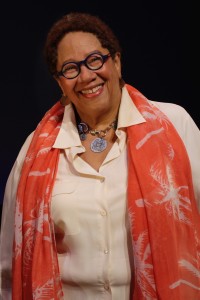
Photo by Fern Seiden
What draws you to August Wilson’s work and is there any specific way you will approach these plays? How do you feel these two works intersect and relate to each other? Wilson exploded onto the scene bringing a fresh theatrical lens through which to view the portrayal os the African American experience. Particularly his portrayals of African American men provided a fresh 360 degree perspective on the inner lives of characters we may only have seen in lesser light. He gave us not only their humor and frustration but also the yearning, caring, humor and poetic pathos we might have only seen under lesser light—if at all. Because of the range of his characters, his plays expanded the range of audiences–particularly drawing more African Americans to the theatre, a feat which in itself was worthy of major note.
The two plays in the Cygnet rep are joined through a unique view of two generations of the same family. Although all but one of his plays take place in the same neighborhood, none of the others incorporate characters who have appeared in another play (though some are mentioned but not seen). It’s an exciting challenge to think of how to mine the context for familial continuity.
How do you feel about directing a Rep? What are the challenges & opportunities? I’ve not done a Rep like this before but the challenge is attractive and daunting. Somewhere I picked up this saying: “If you always do what you always did, you’ll always get what you always got.” I feel secure enough in my work up to now to look forward to stepping into a new-ish way of working. One reassuring factor is that Wilson’s métier provides enough structure and shape to provide a solid base.
What did you look for in actors? I particularly looked for actors with enough readily available experience and versatility to be adept at changing roles. Much of my early career experience was in performing and teaching improvisational theatre so I will bring some of that into the rehearsal process to help everyone become comfortable with the process. The cast is not only talented and delightful to work with and I am confident they will be a joy for audiences to see!
Learn more about SEVEN GUITARS & KING HEDLEY II here. Then book your tickets!

